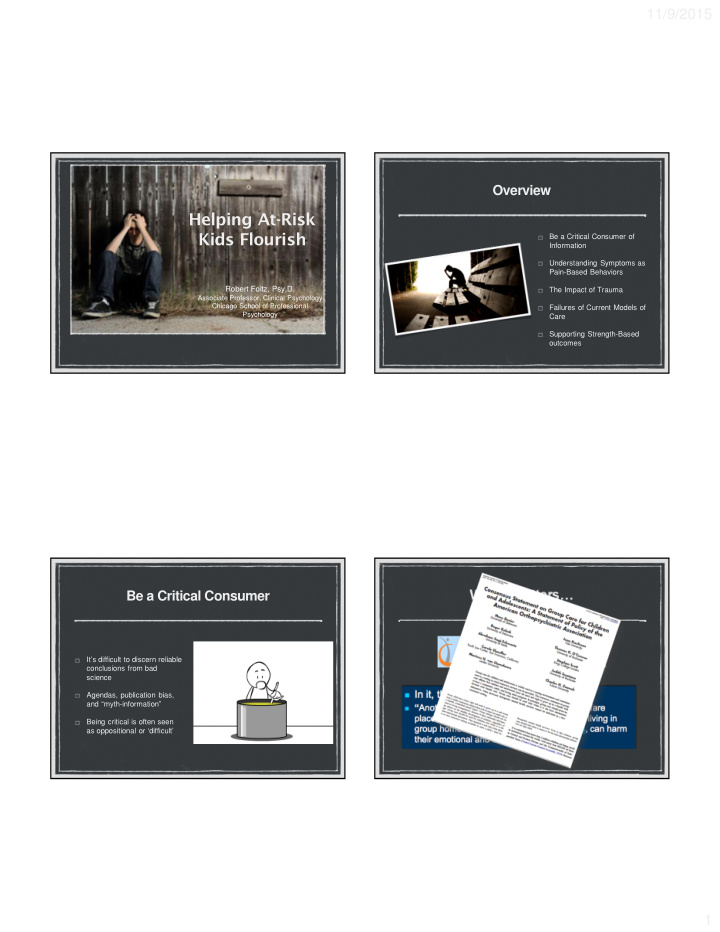



11/9/2015 Overview ���������������� ������������� Be a Critical Consumer of Information Understanding Symptoms as Pain-Based Behaviors Robert Foltz, Psy.D. The Impact of Trauma Associate Professor, Clinical Psychology Chicago School of Professional Failures of Current Models of Psychology Care Supporting Strength-Based outcomes Be a Critical Consumer Why it Matters… It’s difficult to discern reliable conclusions from bad science Agendas, publication bias, and “myth-information” February 16, 2015: Being critical is often seen When Teens and Parents Can’t Get Along: Prevention, Not as oppositional or ‘difficult’ Placement, Is the Answer 1
11/9/2015 CYMBALTA Another example: 16 year old Struggling with Depression Family Conflict Substance abuse Academically successful, but Adolescent clients struggling socially prescribed Cymbalta? Psychiatrist prescribed… It functions as an SNRI Does it work? Cymbalta Cymbalta vs Prozac vs Placebo Look familiar? A Double-Blind Efficacy and Safety Study of Duloxetine Fixed Doses in Children and Adolescents with Major Depressive Disorder, May 2014 463 children & adolescents 36 weeks (10 weeks of treatment) 2 doses of Cymbalta (60mg & 30mg)…224 youth Authors note that the results are “inconclusive” 20mg of Prozac…117 youth, considered active controls because neither the drug (Cymbalta), nor the Placebo…122 youth active control (Prozac), “separated from placebo” Outcome Measures: Childrens Depression at study endpoint. Rating Scale, Adverse Events, Columbia Suicide Severity Rating Scale 2
11/9/2015 If that’s not enough Across Clinical Settings The Cymbalta Package Insert (information provided within the Physician’s Desk Reference) Outpatient Services Inpatient Services Residential Care Juvenile Justice So how do we make sense of all this conflicting Consilience links findings from separate fields to discover simpler information? universal principles. ���������������� 3
11/9/2015 Consilience Values Values Everything should be made as simple as possible but not simpler. Natural Natural Social Social Truth Truth Science Science Science Science ��������������� Experienc Experienc e e If you can’t explain your theory to a six year old, you probably don’t understand it yourself. Truth Cannot Refute Truth Neuroplasticity Neuroplasticity Epigenetics Genes occupy only about 5% of our DNA. The Those Neurons that Fire Together Wire rest is filled with millions of on & off switches - previously considered “junk DNA.” Together 4
11/9/2015 Conduct Disorder, Limited Prosocial Emotions Our Troubled Rather than simply Youth Are in identifying Pain symptoms, we A new DSM 5 diagnosis… need to Poor reliability understand these Requires: behaviors as Lack of Remorse or Guilt reflections of pain Shallow / Deficient Affect Callous, Lack of Empathy Unconcerned with Performance Pediatric Bipolar Disorder has been a diagnostic The Pediatric disaster Bipolar Disaster There was an over 4000% increase in the rate of identifying Bipolar Disorder These youth do NOT convert to adult Bipolar Disorder Preferred treatment are “mood stabilizers” and antipsychotic meds 5
11/9/2015 JACAAP Guidelines How good IS the evidence? As lithium is indicated with the best evidence, how many youth should have been studied to establish this foundation of evidence-based care? Is this enough evidence? The DMDD Distraction Date Sample Total This study included 6 children…3 had to 1977 6 discontinue because of significant worsening of Disruptive Mood symptoms. One developed EEG abnormalities. Dysregulation Disorder 25 youth diagnosed with Bipolar Disorder & secondary 3 outburst per week 1998 13 substance abuse. 13 were receiving lithium, 12 placebo. Only 4 in the lithium group were diagnosed with Bipolar I 12 months 1972 18 youth diagnosed with psychosis. 18 Irritable & Cranky 6 children selected for research because their 1981 parents were responders to lithium. Authors noted 6 there were 2 “clear cut responders” Two studies also cited, but I could not access these 1990, 1978 43 studies through academic resources. 6
11/9/2015 RDoC � �������� ���� ������������������������������������������� ������������������������������������������ �� ������������������������������������������!� "������������������������������������������� �������������������� ��� ����������������� ���#��������������������#���������$�����$����� ������$��%� �!�"���%��&���������������&���� '������ ( )��������%����$���������������������'��������!� *+�,�������#����������-����������$���� .��������/-��.0�1��2���������������$� ����������� ������1������������������ �$��������������'�����������������������'���� ��������$����������� �������#�������������� ��%����������������� ���$( "�������%� �*+�,�%���������3�������������� ����������%� ����$���������������!�4����� ���%�����%��%��������#11���������������� 1��2�������������&���������#����������������� � ����#�3��'�����#������������������ ��������� �����'���1����������� ���$(� The Adolescent Subjective Experience of The Impact of Trauma Treatment Study 86 youth Adverse Childhood Experiences Placed in Residential Care National Child Traumatic Stress Network Interviewed about their perceptions of Child Trauma Academy / NeuroSequential Model what works - and what doesn’t 7
11/9/2015 Trauma Exposure Dysregulated vs Trauma ACEs Average = 4.6 Bipolar, DMDD, Conduct Disorder…all reflected in dysregulated behaviors & disrupted relationships Analysis between Bipolar & PTSD youth ACEs / CANS symptoms / Treatment Plans No Difference: Trauma & CANS Significant difference: Tx Plans - Med Management vs. Trauma Failure to See the Pain Overall, how do you feel about being on meds? Positive They really help Failure to accurately identify I’m glad I’m taking them I know I need them a youth’s & family’s pain results in failed treatments, Neutral frustrated relationships & Sometimes they help, sometime not poor outcomes Ok. I know some people have to take them Creating safety & trust is essential for effective Negative interventions I wish they were never invented I know I don’t need them Rule Out Trauma before I hate them accepting other diagnoses I don’t like people to know that I’m taking them 8
11/9/2015 Overall, how do you feel The Power of Relationships about being in therapy? Positive Been in it for a long time…it’s very helpful Belonging Good…may be tough at times though Good…it helps me get through Every child needs at least one things – I think everyone should be adult who is irrationally crazy in therapy about him or her. Neutral Alright ����� It’s fine – sometimes helpful �������������� ��������� Negative I don’t like it…they’re too nosey I don’t think I need therapy Evidence-Based We have to think systemically Essentials DBL, published April 2015 Strength-based focus Successful treatment Critiques DSM models of care involves the family Focused on Healthy Outcomes Engagement in school & the for troubled youth community increases the likelihood of sustained When Positive Outcomes are progress not obtained, we should see it as our failure, not that our youth are “too broken” 9
11/9/2015 We Can’t Accept Failure Questions? Comments? Contact RFoltz@theChicagoSchool.edu 312.467.2569 Try again, fail again, fail better. ��������� !�� ���"���#� 10
Recommend
More recommend